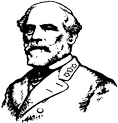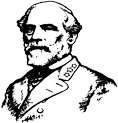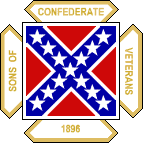 Traveller
Traveller 
 Traveller
Traveller 
Sons of Confederate Veterans, Germantown, Tennessee
Duty, Honor, Integrity, Chivalry ~ Deo Vindici
June 2012 Traveller
Jun 2012 12:43
| Permalink
|
TRAVELLER
The official publication of
the General Robert E. Lee Camp #1640
Sons of Confederate Veterans,
Germantown, Tennessee
Duty, Honor, Integrity,
Chivalry Deo Vindici
June 2012
R.E
LEE CAMP MEETING
Monday
June 11, 2012
Speaker:
Bruce Lynch
Topic:
A power point presentation on President Jefferson Davis artifacts from Mr.
Lynch’s own collection
7:00
p.m. at the Pickering Center
Order
of the Southern Cross
By
John Collier
In
late summer of 1863, the Northern Army of the Cumberland, under the command
of Major general William S. Rosecrans was poised to invade the Southern
heartland; opposing him, the Confederate Army of Tennessee, under the command
of General Braxton Bragg. These two great armies would ultimately clash just
east of Chattanooga, Tennessee in the vicinity of Chickamauga Creek. Victory
here was essential to both more so the South for following several recent
defeats, it could not bear another blow, especially one in the very heart of
the Confederacy.
Added
to the South's spate of troubles was that the morale of the Army of Tennessee
was extremely low and considerable worry in the Army command structure was
freely expressed as to what their soldiers might choose as their terms of
enlistment expired. Poverty and hardship being endured amongst most families
gave considerable fear that a mass exodus in the ranks might be imminent.
With this foremost in everyone's mind, a group of officers came to the
headquarters of Lt. General Leonidas Polk stating the urgent necessity of
taking some immediate action to foster military brotherhood and patriotic
sentiment within the Southern forces. General Polk asked one of his staff
members, Doctor and Chaplain Charles Todd Quintard to represent him at a
meeting, held in fact later that evening to discuss the subject further.
This
meeting of senior staff was called at Tyne's (aka Tyner's) Station, some nine
miles northwest of Chattanooga. Present were Dr. Quintard, Major general
Patrick R. Cleburne, Brigadier General John C. Brown, Brigadier General St.
John R. Liddell, and Colonel Scott Anderson. Cleburne had long since realized
the seriousness of the situation facing them and proposed the creation of an
Order to be called 'The Order of the Comrades of the Southern Cross'.
Cleburne’s belief was such an Order would bring about a unity of purpose and
oneness of action among the member soldiers. On agreement, a committee headed
by Cleburne was appointed to draft a Constitution and this met daily for
about a week thereafter to write the document. On August 28, 1863, the
constitution was adopted unanimously.
Among
other inclusions, the Constitution provided for any Southern Army
commissioned officer in good standing, was automatically qualified for
membership. Such membership required an obligation to remain in the Army for
life, if called to do so. Initiation fees were twenty-five dollars for
general officers, fifteen dollars for field officers, ten dollars for
captains, five dollars for lieutenants and two dollars for NCO's and
privates. In addition however, additional monthly dues were to be levied.
The Constitution
also provided for a charitable fund to which members were required to
contribute one-half of one month's pay annually for two years. This fund
would be used for the relief of families of members who lost their lives in
the military service of the Confederate States. This Charity fund was
obviously designed to relieve soldiers' anxieties as to the suffering of
their families; and to allow them to focus their attention once again to the
great battles yet to be fought.
A timetable was put
n place to present the Order and it's objectives; and to urge its adoption by
all officers and enlisted men. However, word of Cleburne's proposal had
already spread rapidly throughout the army and from the evening of the
following day, before any formal presentation of the Order could be made,
regiment after regiment to a man, demanded their right to re-enlist for life!
Major General
Patrick R. Cleburne proposed the creation of an Order to be called 'The Order
of the Comrades of the Southern Cross’ to bring about a unity of purpose and
oneness of action among the member soldiers
Several Chapters
were hastily organized and were it not for the unfavorable course of events
following hard upon their heels, the Order would no doubt have spread
throughout the Army Units of the Confederacy with some alacrity. Fate however
decreed otherwise. The Battle of Chickamauga Creek, took place soon after,
followed by the occupation of Chattanooga, all conspiring to prevent the
expansion of the Order as intended.
Nonetheless, the
Battle of Chickamauga Creek followed the founding of the ‘Order of the
Comrades of the Southern Cross’ did have one desired effect. The enlistment
crisis was averted but the Army of the Cumberland was still reeling from
defeat, much of its organization thrown into disarray. Without a viable
command structure, most surviving units retreated in disorder to Chattanooga.
The tide of war
turned against the South and the demanding contingencies called for in
subsequent campaigns left no opportunity for implementing the award. The
deaths of two of its founding members, Polk and Cleburne - and the decline of
the Confederate forces doomed any chance of its survival. Thus, the ‘Order of
the Comrades of the Southern Cross’ faded, along with the dreams of the South
(John Collier is
Commander of Camp 2161, Capt John Low CSN)
_______________________________
The
Curious Case of James Weadley
By
Ian Dewar
James Weadley is
remembered on the family memorial stone in Scarborough,
England’s Dean Road Cemetery, where the inscription records he was killed
at the battle of Shiloh in ‘The American War’
James
Weadley was born in York, England in 1825. His mother was born in
Stockton Forest, also near York; and his father came from Hull. We know he
moved to Bridlington sometime in his youth and by 1861, he was married with a
young family and working as a publican at the ‘Bull and Sun’ in Bridlington
(Still trading now!). That same year however, he moved to Memphis in
Tennessee with his family but there, almost immediately things started to go
wrong, with his five year old daughter dying of typhoid shortly after their
arrival.
He,
along with his brother Henry, joined the 2nd Tennessee
Infantry, known as the ‘Irish Regiment’. This unit was made up mainly from the
Irish community in Memphis and when deployed at Shiloh, the regiment suffered
very heavy casualties on the first day when James himself was mortally
wounded and died.
James Weadley is
remembered on the family memorial stone in Scarborough,
England’s Dean Road Cemetery, where the inscription records he was killed
at the battle of Shiloh in ‘The American War’
In 2001 a
Confederate marker was placed at this memorial and since then, the flag has
been replaced or renewed periodically. A surviving member of the family saw
an article someone had written about this stone in the local newspaper and
subsequently wrote a piece in reply, stating one brother had actually fought
for the North whilst the other (presumably James) the South. Available
records however state both brothers were in CSA service.
As it turned out,
they were right! Henry had indeed fought for the North as well as the South.
He later served in the 116th Pennsylvania Infantry, curiously another Irish
regiment and part of the Union Irish Brigade. We can only assume Henry had
been captured and then joined the Union Army - but why? I am guessing that
the fact that these brothers joined Irish regiments is significant; but the
question as to why remains. James and his family had no obvious Irish connections;
and in a regiment that was a part of the Irish Brigade, James’ brother Henry
must have really stood out. In this unit even people from certain parts of
Ireland were considered ‘outsiders’ and it would be little different
in the 2nd Tennessee Infantry.
Perhaps the answer
lies in why he went to America! After all James chose to emigrate to the
South in 1861 when the War was certain to continue; but why
emigrate
there at that time? Was there a distant family connection or perhaps his
reasons were purely political? Unfortunately, in the case of James Weadley,
it is almost certain we will never know.
(Ian Dewar is President of the 290 Foundation headquartered in Middleton
on the Wolds, United Kingdom, dedicated
to preserving the naval history of the
American Civil War. According to its
web site, “The Foundation borrows its
title from Hull #290, a vessel built to the highest standards of British
shipbuilding at the John Laird’s Shipyard at Birkenhead on the River Mersey. Hull #290 would later be known, feared and respected as the CS Alabama)
"The
Pirate 'Alabama,' Alias '290,' Certified to be correct by Captain
Hagar of the 'Brilliant'" (Line engraving published
in "Harper's Weekly", 1862, depicting CSS Alabama burning a
prize. U.S. Naval Historical Center Photograph.)
SCV LIFE MEMBERS
ROSTER
T. Tarry Beasley II
T. Tarry Beasley III
Winston Blackley
Eugene Callaway
John Cole W Ken
Daniel, Jr,
James Anthony Davis
Hubert Dellinger Jr., MD H. Clark Doan Eugene Forrester Robert Freeman Donald
Harrison
Frederick Harrison,
Jr. Frank Holeman M. Gary Hood William P Hunter, Jr
Bobby Lessel Jerry
C. Lunsford
Frank
M. McCroskey Steve McIntyre Ed Murphey Arthur Oliver Charles Wendell Park
Steve Reasons Bill Simmons D Jack Smith Larry J. Spiller, Sr. Larry J.
Spiller, Jr.
Osborn
Turner, IV Charles L Vernon William C. Wilson
Commander’s
Corner
Gentlemen,
MARK BUCHANAN
brought our May meeting an outstanding and detailed explanation of the Peninsular Campaign and
Lee's taking command of the Army. You missed a great presentation is you were
not there. There were 27 members and guests at the meeting that
signed in though the head count was 32. Please remember
to sign
in at our meetings so that you name will be recorded in the minutes.
THE HONOR GUARD
lead by Mike Dougherty out did themselves and presented a flag that he had
made for the Lee Camp which has the SCV logo and our name on
it. The flag is beautiful and will be cherished by the Camp for years to come. Thanks to
the Honor Guard. There are still a few opening for anyone who wishes to join
the Honor Guard and participate in the various events which honor our
ancestors who fought against Federal Terrorism. Their up-coming events are:
5/28 Shiloh, 6/2 Decoration Day at Magnolia Cemetery,6/3 Decoration day at
Elmwood,, Battle of Memphis memorial at Confederate Park 6/6, and Forrest
Birthday in July. Join them, you'll love it!
LARRY SPILLAR, one of our members
on the Governors appointed Committee on consolidation
of the Schools in Shelby County, gave us an up-date on the progress and the difficulty of making headway for
the reforming and cost cutting that is needed.
VISITORS are
welcome so bring a few to the next meeting, remember if you bring a new
member into the Camp you will receive a silver dollar with the Confederacy's
Seal on one side and a full once of pure silver. It is quite impressive.
BILL SIMMONS one of
our past commanders is in the hospital with a very severe foot infection.
Please put him on your prayer list and see if there is anything you can do to
assist him.
BATTLE OF MEMPHIS
is Wednesday June 6th and will be celebrated at high noon with the firing of
Bankhead's Noble Brothers original cannon and one representing the Appeal
Battery. There will be a short program that will include a talk on the naval
battle which was the largest inland naval battle of the war and terribly
lopsided with about 4 to 1 odds against us. I hope that you were there to see
and hear the event. It is the 150th anniversary of the battle.
KROGER CARDS have
you gotten yours yet?
VOLUNTEER for the
Calling committee or the Honor Guard and get involved. Have a job in mind you
would like to do for the Camp? Just let me know and we'll get started.
Tarry Beasley,
Commander
June
Camp Meeting Speaker - Bruce Lynch
Our June Camp
meeting speaker will be Mr. Bruce Lynch, who is originally from Murfreesboro,
Tennessee, and has been a Dentist for 32 years with local practice. Mr.
Lynch’s Great, Great Grandfather, Ephram F Ragsdale, was a member of the 44th
Tennessee Infantry out of Franklin, Tennessee. A unit with a glorious history
and from which very few survived the war. There is a complete website
dedicated to this regiment. Another of Mr. Lynch’s Great, Great Grandfathers,
Moses Swan Lynch, from Christiana, Tennessee ironically spent the entire war
destroying railroads due to his "extensive railroad knowledge". At
our next Camp meeting scheduled for 7:00 PM, June 11 at the Germantown
Pickering Center Mr. Lynch will share a power point presentation on President
Jefferson Davis artifacts from his personal collection.
|
|||||||||||||||||||||||||||||||||||||||||||||||||||||||||||||||||||||||
|
|
|||||||||||||||||||||||||||||||||||||||||||||||||||||||||||||||||||||||
|
|
|
||||||||||||||||||||||||||||||||||||||||||||||||||||||||||||||||||||||
|
|
|
|
|||||||||||||||||||||||||||||||||||||||||||||||||||||||||||||||||||||
|
|
|
|
|||||||||||||||||||||||||||||||||||||||||||||||||||||||||||||||||||||
|
|
|
|
|||||||||||||||||||||||||||||||||||||||||||||||||||||||||||||||||||||
|
|
|
|
|||||||||||||||||||||||||||||||||||||||||||||||||||||||||||||||||||||
|
|
|
|
|||||||||||||||||||||||||||||||||||||||||||||||||||||||||||||||||||||
|
|
|
|
|||||||||||||||||||||||||||||||||||||||||||||||||||||||||||||||||||||
|
|
|||||||||||||||||||||||||||||||||||||||||||||||||||||||||||||||||||||||
|
|
|
||||||||||||||||||||||||||||||||||||||||||||||||||||||||||||||||||||||
|
|
|
|
|||||||||||||||||||||||||||||||||||||||||||||||||||||||||||||||||||||
|
|
|
|
|||||||||||||||||||||||||||||||||||||||||||||||||||||||||||||||||||||
|
|
|
|
|||||||||||||||||||||||||||||||||||||||||||||||||||||||||||||||||||||
|
|
|
|
|||||||||||||||||||||||||||||||||||||||||||||||||||||||||||||||||||||
|
|
|
|
|||||||||||||||||||||||||||||||||||||||||||||||||||||||||||||||||||||
![]()
Traveller is the monthly newsletter of:
The General Robert E. Lee Camp #1640
Sons of Confederate Veterans
and
The Mary Custis Lee Chapter,
Order of the Confederate Rose
P.O. Box 171251
Memphis, Tennessee 38187
Steve M. McIntyre, Editor
